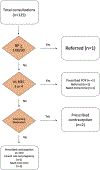Implementation of a pharmacist-led hormonal contraceptive prescribing service in a campus community pharmacy in Indiana, United States
- PMID: 35577148
- PMCID: PMC9378444
- DOI: 10.1016/j.contraception.2022.05.004
Implementation of a pharmacist-led hormonal contraceptive prescribing service in a campus community pharmacy in Indiana, United States
Abstract
Objective(s): College-age people have the highest numbers of unintended pregnancies and pharmacies within college campuses are in a unique position to meet student needs. Our objective was to implement a pharmacist contraceptive prescribing service in a campus pharmacy and examine the service utilization.
Study design: The Purdue University Pharmacy (Indiana, United States) implemented a pharmacist hormonal contraception prescribing service via a collaborative drug therapy management agreement with the campus student health center. The collaborative drug therapy management agreement enables pharmacists to independently prescribe pills, patches, rings, injections, and emergency contraception to students meeting eligibility criteria. After completing a patient health screening and blood pressure check, the pharmacist discusses the eligible method(s) and prescribes up to a 12-month supply. A referral to another provider for long-acting reversible contraception or further evaluation may also be provided. We collected basic information about each encounter (e.g., age, blood pressure, method of contraception prescribed, and time).
Results: During the 2020-2021 academic year, 125 prescribing consultations took place with an average appointment length of 20 minutes (range, 12-65 minutes). The median patient age was 21 years (range, 18-30 years). Eligible patients (n = 123, 98%) received a prescription and 119 (95%) prescriptions were written: combined oral pill (n = 91, 77%), injection (n = 12, 10%), patch (n = 6, 5%), vaginal ring (n = 5, 4%), and progestin only pill (n = 5, 4%).
Conclusion(s): The pharmacist contraception prescribing service developed by the Purdue University Pharmacy and Student Health Center is a unique approach to meeting the needs of students. Few external resources are required for implementation, and most patients were medically eligible to receive hormonal contraception.
Implications: Collaboration between on-campus student health centers and pharmacies can be explored as 1 approach to increase access to hormonal contraception for students.
Keywords: Community pharmacy services; Contraception; Health services accessibility; Pharmacists; Student health services.
Copyright © 2022 Elsevier Inc. All rights reserved.
Figures



Similar articles
-
Pharmacist prescription and access to hormonal contraception for Medicaid-insured women in Oregon.Contraception. 2020 Oct;102(4):262-266. doi: 10.1016/j.contraception.2020.07.001. Epub 2020 Jul 8. Contraception. 2020. PMID: 32652093 Free PMC article.
-
Assessing student and patient perspectives on pharmacist-prescribed hormonal contraceptives.J Am Pharm Assoc (2003). 2025 Jan-Feb;65(1):102259. doi: 10.1016/j.japh.2024.102259. Epub 2024 Oct 3. J Am Pharm Assoc (2003). 2025. PMID: 39368549
-
Characterizing pharmacist-prescribed hormonal contraception services and users in California and Oregon pharmacies.Contraception. 2019 Apr;99(4):239-243. doi: 10.1016/j.contraception.2018.12.002. Epub 2018 Dec 16. Contraception. 2019. PMID: 30562478
-
Curricular Considerations for Preparing Student Pharmacists to Prescribe Hormonal Contraception.Am J Pharm Educ. 2022 Apr;86(4):8667. doi: 10.5688/ajpe8667. Epub 2021 Aug 12. Am J Pharm Educ. 2022. PMID: 34385172 Free PMC article. Review.
-
Patient and pharmacist perspectives on pharmacist-prescribed contraception: A systematic review.Contraception. 2021 Feb;103(2):66-74. doi: 10.1016/j.contraception.2020.10.012. Epub 2020 Oct 29. Contraception. 2021. PMID: 33130109 Free PMC article.
Cited by
-
Patient-Centred Counselling Tools for Dispensing Contraceptives in Community Pharmacy Settings: A Systematic Review.Open Access J Contracept. 2024 Nov 30;15:119-133. doi: 10.2147/OAJC.S487417. eCollection 2024. Open Access J Contracept. 2024. PMID: 39634191 Free PMC article. Review.
References
-
- Centers for Disease Control and Prevention. Unintended pregnancy. Division of Reproductive Health, National Center for Chronic Disease Prevention and Health Promotion. U.S. Department of Health & Human Services, https://www.cdc.gov/reproductivehealth/contraception/unintendedpregnancy...; June 28, 2021. [accessed 11 March 2022].
-
- The National Campaign to Prevent Teen and Unplanned Pregnancy . Briefly...Unplanned pregnancy among college students and strategies to address it, https://powertodecide.org/sites/default/files/resources/primary-download...; 2015. [accessed 11 March 2022].
-
- American College Health Association. American College Health Association-National College Health Assessment III: Reference Group Executive Summary Spring 2021, https://www.acha.org/documents/ncha/NCHA-III_SPRING-2021_REFERENCE_GROUP...; 2021 [accessed 3 March 2022].
-
- Healthy People 2030. Family planning, overview and objectives. Office of Disease Prevention and Health Promotion, U.S. Department of Health and Human Services, https://health.gov/healthypeople/objectives-and-data/browse-objectives/f.... [accessed 11 March 2022].
MeSH terms
Substances
Grants and funding
LinkOut - more resources
Full Text Sources

